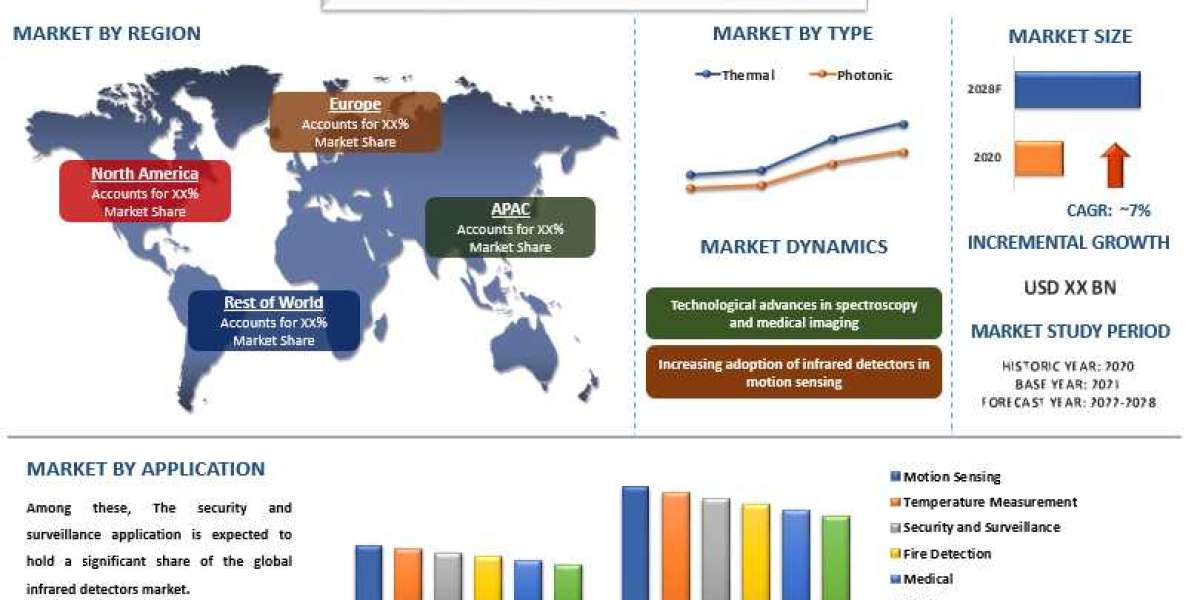Infrared sensors (IR sensors) are radiation-sensitive optoelectronic components with spectral sensitivity in the infrared wavelength range from 780 nm to 50 µm. IR sensors are now widely used in motion detectors, used in building services to turn on lamps, and in alarm systems to detect uninvited guests. A sensor element detects thermal radiation (infrared radiation) that varies in time and space due to human movement within a defined angular range. Such infrared sensors meet relatively low requirements and are inexpensive mass-produced products.
According to UnivDatos Market Insights (UMI)’ research report “Global Infrared Detector Market”, the market is expected to witness robust growth of 7% during the forecast period. The rising demand for security and surveillance cameras in different industries and an increase in the deployment of smart home devices are fueling the growth Further, the market is expected to grow at a steady rate owing to the increasing adoption of infrared detectors in motion sensing and technological advances in spectroscopy and medical imaging. Furthermore, factors such as the rising demand for security and surveillance cameras in different industries and an increase in the deployment of smart home devices are also fueling the growth of the infrared detector market. For instance, according to the non-profit organization SafeHome.org, 38% of Americans own a home security product, of those, 18.2% report owning a video camera, doorbell, or both.
Unlock The Table of Content, And Request a Sample Report - https://univdatos.com/get-a-free-sample-form-php/?product_id=27863
Based on spectral range, the market is divided into near-wave infrared, short-wave infrared, medium-wave infrared, and long-wave infrared. The long-wave infrared held a significant share of the global infrared detector market in 2020. The ability to provide excellent detection capabilities even in low light and detect signs of heat are some of the major factors driving the growth of this segment. Light with a wavenumber of 12,500 to 4,000 cm is called near-infrared light. This wavelength is just outside the range of human vision and can sometimes provide sharper details than visible light imaging.
Based on application, the market is segmented into motion sensing, temperature measurement, security and surveillance, fire detection, medical, and others. The security and surveillance application is expected to hold a significant share of the global infrared detectors market. From space to chemical composition studies, terrestrial environmental observations, oceanographic observations, and strategic military observations, the increasing use of atmospheric research or sense are driving the growth of this segment.
APAC to witness robust CAGR
In 2020, North America held a significant share of the global infrared detector market. This is largely due to the presence of the major infrared detector manufacturers in the region coupled with the increasing applications for surveillance and security, and motion sensing in the commercial, residential, and defense sectors are also influencing the growth of this market in the region. Moreover, the region is seeing increased demand for infrared detectors from the military and defense sector, as well as temperature measurement and industrial applications. The introduction of remote sensing technology has supplied crucial intelligence data to protection forces. Hence, the increasing budget of major space agencies is further contributing to the growth of this market in the region. For instance, in 2020, a budget of USD 23 Bn was allocated to NASA, and this number increased to more than USD 24 Bn in 2022.
For More Informative Information, Please Visit Us – https://univdatos.com/report/infrared-detector-market/
According to UnivDatos Market Insights (UMI)’, the key players with a considerable market share in the infrared detector market are Excelitas Technologies Corp., Teledyne FLIR LLC, Hamamatsu Photonics K.K., Murata Manufacturing Co. Ltd., Texas Instruments Incorporated, Omron Corporation, Raytheon Technologies Corporation, Nippon Avionics Co. Ltd., Lynred USA, and Honeywell International Inc.
“Global Infrared Detector Market” provides comprehensive qualitative and quantitative insights on the industry potential, key factors impacting sales and purchase decisions, hotspots, and opportunities available for the market players. Moreover, the report also encompasses the key strategic imperatives for success for competitors along with strategic factorial indexing measuring competitors’ capabilities on different parameters. This will help companies in the formulation of go-to-market strategies and identifying the blue ocean for its offerings.
Market Segmentation:
- By Type (Thermal and Photonic)
- By Spectral Range (Near-wave Infrared, Short-wave Infrared, Medium-wave Infrared, and Long-wave Infrared)
- By Technology (Cooled and Uncooled)
- By Application (Motion Sensing, Temperature Measurement, Security and Surveillance, Fire Detection, Medical, and Others)
- By Region (North America, Europe, Asia-Pacific, Rest of the World)
- By Company (Excelitas Technologies Corp., Teledyne FLIR LLC, Hamamatsu Photonics K.K., Murata Manufacturing Co. Ltd., Texas Instruments Incorporated, Omron Corporation, Raytheon Technologies Corporation, Nippon Avionics Co. Ltd., Lynred USA, and Honeywell International Inc.)
Key questions answered in the study:
- What are the current and future trends of the global infrared detector industry?
- How the industry has been evolving in terms of type, spectral range, technology, and application?
- How the competition has been shaping across the countries followed by their comparative factorial indexing?
- What are the key growth drivers and challenges for the global infrared detector industry?
- What is the customer orientation, purchase behavior, and expectations from the global infrared detector suppliers across various region and countries?














